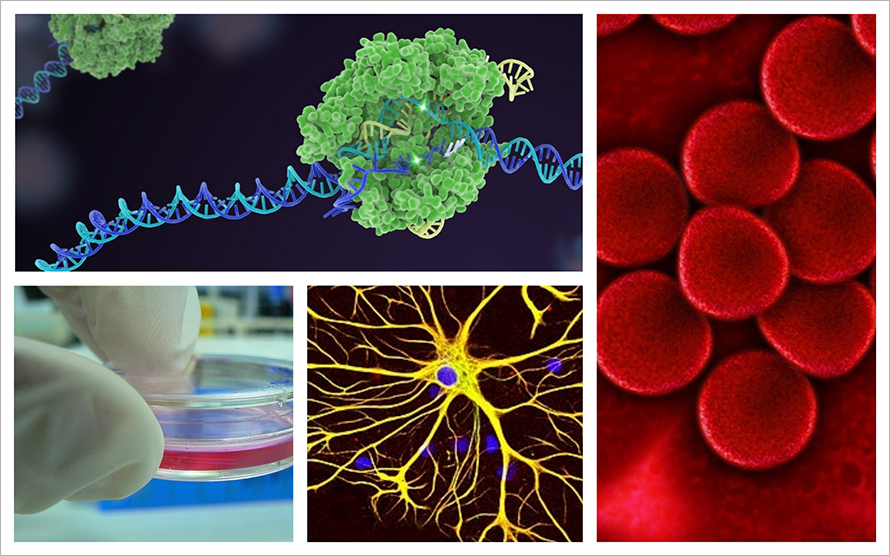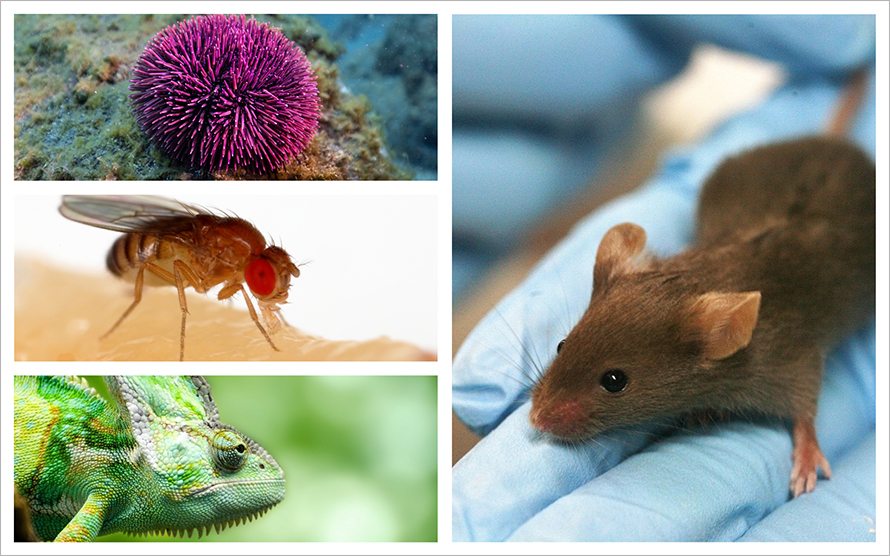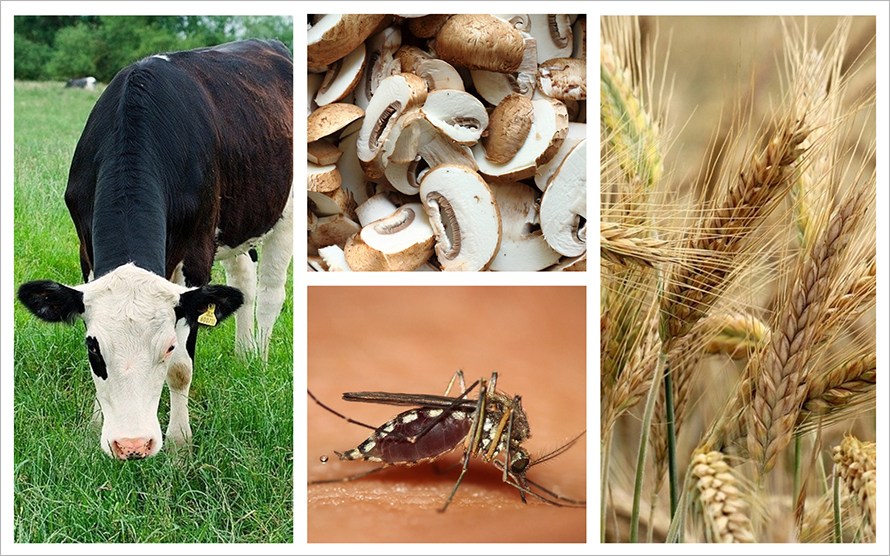Dozens of ways of using CRISPR
The mechanistic understanding of bacterial immune systems recognized by this year's Nobel Prize in Chemistry has engendered an explosion of creative uses for the technology. There are far too many to cover them all, but here are snapshots of interesting papers.
Some approaches are clearly translational, while others solve problems in basic research. Either way, the first thing any CRISPR scientist will tell you about their field is that basic research can have applications no one would have predicted.
These approaches are not all ready for clinical or industrial use, and some may never go that far. Researchers are still learning how to prevent unintended side effects of CRISPR editing.

Basic biology in cultured cells
Some of the cleverest CRISPR applications start out as publications answering a design question: "Would this work?" Researchers have adapted the basic template of an RNA-guided protein effector in myriad ways. RNA-directed targeting has been used …
- As a molecular recorder that logs transcription events in a living cell.
- To edit DNA only in cells illuminated with blue light, through photo-activated dimerization.
- To knock out every gene in a cancer cell line one by one, finding drivers of drug resistance.
- To alter genome architecture by bringing two DNA regions together, forming reversible loops in the chromatin using dimerizable Cas9 proteins.
- To alter a single target base in DNA without introducing a double-stranded cut, using a cytidine deamidase, or similar enzyme, targeted using dCas9. Such editors can convert C to G, G to A, T to C or A to G.
- As a potential antiviral that may target many related viruses.
- To rewrite epigenetic modifications; researchers have used fusion proteins made of catalytically inactive Cas9 fused to histone acetyltransferases , methyltransferases and other enzymes to find out what happens when epigenetic marks on specific sequences change.
- To screen for enhancer regions and other functional genomic elements using a panel of guide RNAs directed to regions outside of the coding region of a growth-essential gene.
- To find synthetic lethal genetic interactions, which exist when a cell can survive without either of two genes but cannot survive having both removed.
- To manipulate gene expression; researchers can either reduce RNA levels by blocking RNA polymerase from binding, or increase them by recruiting transcriptional activators to DNA.
- With guide RNA constructs that can take two conformations, to run logic-gated or coincidence-detecting Cas12 and Cas9 systems.

In model organisms in the lab
- To generate more realistic, genetically diverse tumors in animal models.
- To knock a gene into only certain tissues in a mouse by expressing Cas9 globally, but delivering sgRNAs only to selected tissues.
- To diminish the population of sub-subtypes of T cells that contribute to diseases like encephalitis by disrupting a glycolysis enzyme that is normally dispensable but required to survive in some microenvironments.
- To generate Cas9 systems that are cell type–specific because of endogenous microRNAs blocking or enabling expression of a Cas9 system or an anti-CRISPR protein.
- To understand the biology of organisms that have never before been used as genetic model organisms, such as lizard, squid, snail and sea urchin.

In agriculture and environmental management
To power gene drives that can propagate a new allele through populations more rapidly than it usually would be transmitted through general reproduction — for example, to render malaria-carrying mosquitoes inhospitable to the malaria parasite.
- To understand how crops synthesize vitamins important to human health and perhaps use that information to breed or engineer more nutritious varieties.
- To breed dairy cattle without horns, eliminating the need for painful de-horning of calves.
- To study microbes that could be used to produce biofuels, but are poorly characterized compared to E. coli and various pathogens.
- To develop more resilient crops through microbiome engineering.

In clinical settings
- To produce diagnostics that detect genes from SARS-COV-2, the virus that causes COVID-19, or other pathogens.
- To excise latent HIV from cellular reservoirs using CRISPR/Cas9 targeting the long tandem repeats in the HIV genome.
- To generate new skin cells for transplant onto patients with a blistering skin disease.
- To expand the pool of potential donors to HIV-positive patients by editing CCR5, the viral receptor, in an otherwise matched donor prior to transplant.
- To screen for regulators within cells that might govern the toxicity of antibody/drug conjugates used to deliver targeted chemotherapy — and could help predict which patients will benefit and which will experience more harmful side effects.
- As a target in bacteria with CRISPR systems, for new antibiotics that work by sensitizing certain strains to phages: for example, targeting only antimicrobial-resistant or virulence gene-carrying bacteria.
- To screen for new activators or inhibitors of G-protein–coupled receptors, including — by coexpressing a variety of G proteins and GPCRs — ligands that are selective for only certain receptor/signal protein pairs.
- To alter methylation patterns in cultured neurons derived from induced pluripotent stem cells, restoring expression of the gene FMR1 that is associated with fragile X syndrome.
- To deliver gene therapy for sickle cell anemia and the related disease beta-thalassemia, genetic disorders that affect the hemoglobin protein; patients received a bone marrow transplant with CRISPR/Cas9-edited bone marrow cells modified to upregulate the expression of fetal hemoglobin.
Did we miss an application of CRISPR technology that's important to you? Let us know by emailing asbmbtoday@asbmb.org, and we'll consider adding it to the list.
Enjoy reading ASBMB Today?
Become a member to receive the print edition monthly and the digital edition weekly.
Learn moreGet the latest from ASBMB Today
Enter your email address, and we’ll send you a weekly email with recent articles, interviews and more.
Latest in Science
Science highlights or most popular articles

From the journals: JLR
How lipogenesis works in liver steatosis. Removing protein aggregates from stressed cells. Linking plasma lipid profiles to cardiovascular health. Read about recent papers on these topics.

Small protein plays a big role in viral battles
Nef, an HIV accessory protein, manipulates protein expression in extracellular vesicles, leading to improved understanding of HIV-1 pathogenesis.

Genetics studies have a diversity problem that researchers struggle to fix
Researchers in South Carolina are trying to build a DNA database to better understand how genetics affects health risks. But they’re struggling to recruit enough Black participants.

Scientists identify new function of learning and memory gene common to all mammalian brain cells
Findings in mice may steer search for therapies to treat brain developmental disorders in children with SYNGAP1 gene mutations.

From the journals: JBC
Biased agonism of an immune receptor. A profile of missense mutations. Cartilage affects tissue aging. Read about these recent papers.

Cows offer clues to treat human infertility
Decoding the bovine reproductive cycle may help increase the success of human IVF treatments.

